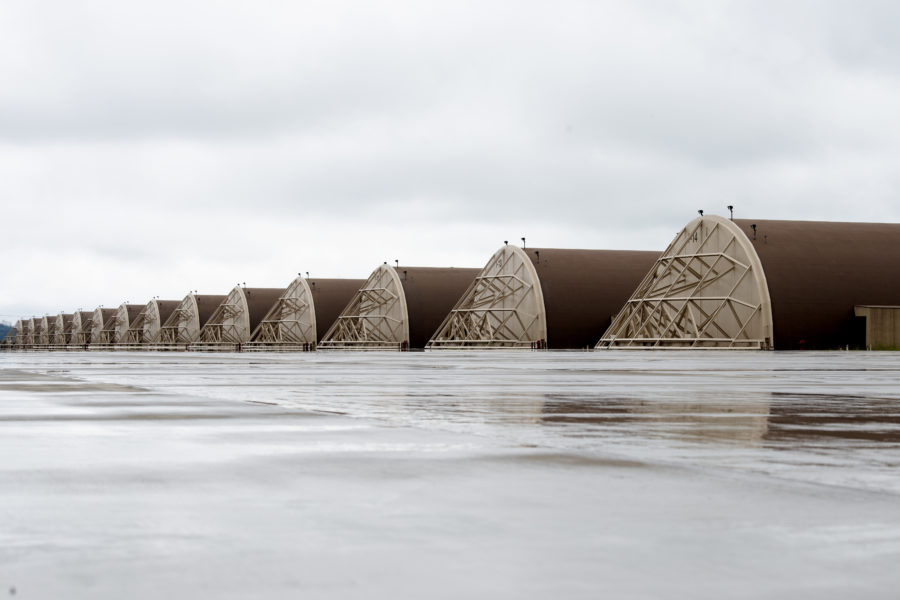A group of lawmakers are pushing for the Pentagon to move with more urgency in fortifying ground protection of U.S. aircraft across the Indo-Pacific, arguing it is necessary to defend against the threat of China.
Rep. John Moolenaar (R-Mich.)—the chair of the Select Committee on U.S.-China competition—Sen. Marco Rubio (R-Fla.), and 13 other lawmakers all sent a letter last week to Air Force Secretary Frank Kendall and Navy Secretary Carlos Del Toro about the issue, comparing China’s investments in hardened aircraft shelters to the U.S. and asking for more information on the Air Force and Navy’s plans for such structures.
A hardened aircraft shelter (HAS), typically made of concrete or other durable materials, provides enhanced protection for aircraft against strikes. These shelters vary in size, from single-aircraft protection to modern facilities incorporating maintenance capabilities within the shelter.
“It would require weapons such as ground penetration or bunker buster bombs to breach these thick, reinforced concrete barriers,” Daniel Rice, China military and political strategy subject matter expert at the Krulak Center for Innovation and Future Warfare, told Air & Space Forces Magazine. He added that the shelters mitigate fragmentation from precision-guided bombs or other munitions aimed at damaging runways, therefore aircraft can survive even when an initial strike hits the runway, allowing for rapid runway repairs.
In the letter, lawmakers referenced ongoing research highlighting a disparity in the construction of hardened aircraft shelters between China and the U.S. According to the studies, China has built over 400 aircraft shelters in the last decade, compared to only 22 by the U.S. in the Indo-Pacific region.
Lawmakers also cited a 2023 wargame conducted by the Center for Strategic and International Studies looking at a potential Chinese invasion of Taiwan, which found that approximately 90 percent of aircraft losses for the U.S. would occur on the ground in the scenario, rather than from air combat. Rice echoed these concerns.
“If the Sino-U.S. relationship devolves into conflict, and there is some sort of preemptive or first strike on specifically U.S. facilities, the survivability factor that hardened aircraft shelters provide is currently highly lacking, while China maintains a more hardened and survivable posture with these shelters and underground facilities,” said Rice. “It also suggests that any strike against Chinese targets would likely be less effective or require more munitions to achieve similar effects.”
Rice stressed the urgency of building these shelters on a key location like Guam. Currently, there is no HAS on Guam, and the 22 shelters the Pentagon has built in the last 10 years in the region were limited to South Korea and Japan. Guam, a largely exposed island with no mountains, is often a favorable deployment site for costly assets like bombers and fighters for regional exercises.
“There are strategic assets in places such as Hawaii or Alaska, but there is also a much higher political cost for China to strike those locations,” said Rice. “Guam, on the other hand, while serving as a focal point for U.S. forces flowing in and out, it is not a U.S. state. So it is more vulnerable and less politically costly for China in the scenario of conflict.”
Lawmakers also noted a reduced DOD military construction budget for the Indo-Pacific region from fiscal 2023 to 2024. Of the Pentagon’s $15.7 billion budget for military construction worldwide in 2024, less than two percent is allocated for base resilience projects in the region. Rice, who has written about China’s expansion of hardened aircraft shelters, noted that building hardened aircraft shelters and bunkers is a cost-effective way that doesn’t require high-tech to protect limited forces.
“It depends on the project scale, but generally, it can be easily built within a year or two, as long as funding is available and contracts are in place to proceed with construction, along with the necessary workforce,” said Rice.
Given the large losses expected in a possible conflict with China and the costs of replacing existing aircraft with newer ones, the U.S. Air Force and other services should focus on the survivability of their current stocks, Rice said.
“If there is a conflict between China and the U.S., there’s always a high level of attrition between both sides,” said Rice. “It’s a losing fight in terms of cost proposition and then time to reconstitute the force that is used. So anything that we can do to help cost curve and resource curve is beneficial. And if you multiply that across numerous hardened shelters and underground facilities for other critical resources, such as fuel, that’s a huge win when you’re trying to flow forces that will help us sustain any sort of conflict or power projection into the area.”
In their letter, members of Congress requested the secretaries provide them with information by May 29 on:
- What steps the Air Force and Navy have taken to bolster their passive defenses
- What plans they have to build hardened aircraft shelters or underground bunkers in the Indo-Pacific
- Whether they plan to request extra funding for those projects
- Whether there are any ways to increase the speed of these military construction projects


